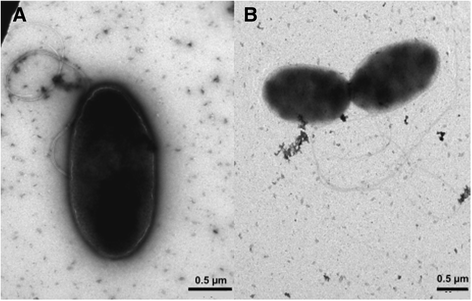Draft genome sequence of the marine Rhodobacteraceae strain O3.65, cultivated from oil-polluted seawater of the Deepwater Horizon oil spill
- PMID: 27777651
- PMCID: PMC5064897
- DOI: 10.1186/s40793-016-0201-7
Draft genome sequence of the marine Rhodobacteraceae strain O3.65, cultivated from oil-polluted seawater of the Deepwater Horizon oil spill
Abstract
The marine alphaproteobacterium strain O3.65 was isolated from an enrichment culture of surface seawater contaminated with weathered oil (slicks) from the Deepwater Horizon (DWH) oil spill and belongs to the ubiquitous, diverse and ecological relevant Roseobacter group within the Rhodobacteraceae. Here, we present a preliminary set of physiological features of strain O3.65 and a description and annotation of its draft genome sequence. Based on our data we suggest potential ecological roles of the isolate in the degradation of crude oil within the network of the oil-enriched microbial community. The draft genome comprises 4,852,484 bp with 4,591 protein-coding genes and 63 RNA genes. Strain O3.65 utilizes pentoses, hexoses, disaccharides and amino acids as carbon and energy source and is able to grow on several hydroxylated and substituted aromatic compounds. Based on 16S rRNA gene comparison the closest described and validated strain is Phaeobacter inhibens DSM 17395, however, strain O3.65 is lacking several phenotypic and genomic characteristics specific for the genus Phaeobacter. Phylogenomic analyses based on the whole genome support extensive genetic exchange of strain O3.65 with members of the genus Ruegeria, potentially by using the secretion system type IV. Our physiological observations are consistent with the genomic and phylogenomic analyses and support that strain O3.65 is a novel species of a new genus within the Rhodobacteraceae.
Keywords: Deepwater Horizon; Hydrocarbon; Marine bacteria; Oil degradation; Oil spill; Rhodobacteraceae; Rhodobacterales; Roseobacter.
Figures



Similar articles
-
Tritonibacter horizontis gen. nov., sp. nov., a member of the Rhodobacteraceae, isolated from the Deepwater Horizon oil spill.Int J Syst Evol Microbiol. 2018 Mar;68(3):736-744. doi: 10.1099/ijsem.0.002573. Epub 2018 Feb 6. Int J Syst Evol Microbiol. 2018. PMID: 29458459
-
Hydrocarbon-degradation and MOS-formation capabilities of the dominant bacteria enriched in sea surface oil slicks during the Deepwater Horizon oil spill.Mar Pollut Bull. 2018 Oct;135:205-215. doi: 10.1016/j.marpolbul.2018.07.027. Epub 2018 Jul 14. Mar Pollut Bull. 2018. PMID: 30301032
-
Reclassification of Roseobacter gallaeciensis Ruiz-Ponte et al. 1998 as Phaeobacter gallaeciensis gen. nov., comb. nov., description of Phaeobacter inhibens sp. nov., reclassification of Ruegeria algicola (Lafay et al. 1995) Uchino et al. 1999 as Marinovum algicola gen. nov., comb. nov., and emended descriptions of the genera Roseobacter, Ruegeria and Leisingera.Int J Syst Evol Microbiol. 2006 Jun;56(Pt 6):1293-1304. doi: 10.1099/ijs.0.63724-0. Int J Syst Evol Microbiol. 2006. PMID: 16738106
-
A critical review of marine snow in the context of oil spills and oil spill dispersant treatment with focus on the Deepwater Horizon oil spill.Mar Pollut Bull. 2018 Oct;135:346-356. doi: 10.1016/j.marpolbul.2018.07.028. Epub 2018 Jul 18. Mar Pollut Bull. 2018. PMID: 30301046 Review.
-
Ecological impacts of the deepwater horizon oil spill: implications for immunotoxicity.Toxicol Pathol. 2012;40(2):315-20. doi: 10.1177/0192623311428474. Epub 2011 Nov 21. Toxicol Pathol. 2012. PMID: 22105647 Review.
Cited by
-
Dispersant Enhances Hydrocarbon Degradation and Alters the Structure of Metabolically Active Microbial Communities in Shallow Seawater From the Northeastern Gulf of Mexico.Front Microbiol. 2019 Oct 18;10:2387. doi: 10.3389/fmicb.2019.02387. eCollection 2019. Front Microbiol. 2019. PMID: 31749769 Free PMC article.
-
Fine-scale succession patterns and assembly mechanisms of bacterial community of Litopenaeus vannamei larvae across the developmental cycle.Microbiome. 2020 Jul 3;8(1):106. doi: 10.1186/s40168-020-00879-w. Microbiome. 2020. PMID: 32620132 Free PMC article.
References
-
- Teeling H, Fuchs BM, Becher D, Klockow C, Gardebrecht A, Bennke CM, Kassabgy M, Huang SX, Mann AJ, Waldmann J, et al. Substrate-controlled succession of marine bacterioplankton populations induced by a phytoplankton bloom. Science. 2012;336(6081):608–611. doi: 10.1126/science.1218344. - DOI - PubMed
-
- Wemheuer B, Gullert S, Billerbeck S, Giebel HA, Voget S, Simon M, Daniel R. Impact of a phytoplankton bloom on the diversity of the active bacterial community in the southern North Sea as revealed by metatranscriptomic approaches. Fems Microbiol Ecol. 2014;87(2):378–389. doi: 10.1111/1574-6941.12230. - DOI - PubMed
Publication types
LinkOut - more resources
Full Text Sources
Other Literature Sources
Molecular Biology Databases

